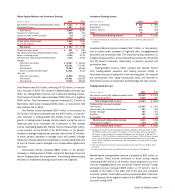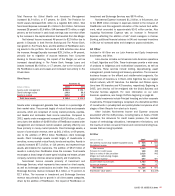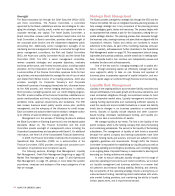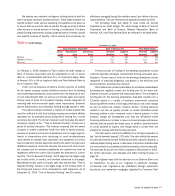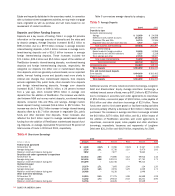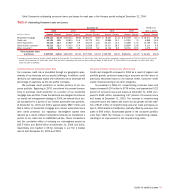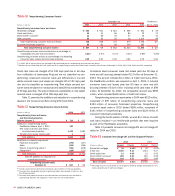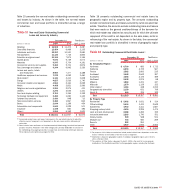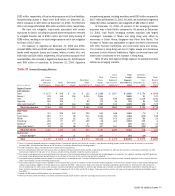Bank of America 2004 Annual Report Download - page 57
Download and view the complete annual report
Please find page 57 of the 2004 Bank of America annual report below. You can navigate through the pages in the report by either clicking on the pages listed below, or by using the keyword search tool below to find specific information within the annual report.
56 BANK OF AMERICA 2004
On- and Off-balance Sheet Financing Entities
Off-balance Sheet Commercial Paper Conduits
In addition to traditional lending, we also support our customers’
financing needs by facilitating their access to the commercial paper
markets. These markets provide an attractive, lower-cost financing
alternative for our customers. Our customers sell assets, such as
high-grade trade or other receivables or leases, to a commercial
paper financing entity, which in turn issues high-grade short-term
commercial paper that is collateralized by the assets sold.
Additionally, some customers receive the benefit of commercial paper
financing rates related to certain lease arrangements. We facilitate
these transactions and collect fees from the financing entity for the
services it provides including administration, trust services and
marketing the commercial paper.
We receive fees for providing combinations of liquidity, standby
letters of credit (SBLCs) or similar loss protection commitments, and
derivatives to the commercial paper financing entities. These forms
of asset support are senior to the first layer of asset support pro-
vided by customers through over-collateralization or by support pro-
vided by third parties. The rating agencies require that a certain
percentage of the commercial paper entity’s assets be supported by
both the seller’s over-collateralization and our SBLC in order to
receive their respective investment rating. The SBLC would be drawn
on only when the over-collateralization provided by the seller is not
sufficient to cover losses of the related asset. Liquidity commitments
made to the commercial paper entity are designed to fund scheduled
redemptions of commercial paper if there is a market disruption or
the new commercial paper cannot be issued to fund the redemption
of the maturing commercial paper. The liquidity facility has the same
legal priority as the commercial paper. We do not enter into any other
form of guarantee with these entities.
We manage our credit risk on these commitments by subjecting
them to our normal underwriting and risk management processes. At
December 31, 2004 and 2003, the Corporation had off-balance sheet
liquidity commitments and SBLCs to these entities of $23.8 billion
and $21.6 billion, respectively. Substantially all of these liquidity com-
mitments and SBLCs mature within one year. These amounts are
included in Table 8. Net revenues earned from fees associated with
these off-balance sheet financing entities were approximately $80 million
and $72 million for 2004 and 2003, respectively.
From time to time, we may purchase some of the commercial
paper issued by certain of these entities for our own account or acting
as a dealer on behalf of third parties. Derivative instruments related
to these entities are marked to market through the Consolidated
Statement of Income. SBLCs are initially recorded at fair value in
accordance with Financial Accounting Standards Board (FASB)
Interpretation No. 45, “Guarantor’s Accounting and Disclosure
Requirements for Guarantees” (FIN 45). Liquidity commitments and
SBLCs subsequent to inception are accounted for pursuant to SFAS
No. 5, “Accounting for Contingencies” (SFAS 5), and are discussed
further in Note 12 of the Consolidated Financial Statements.
In January 2003, the FASB issued FASB Interpretation No. 46,
“Consolidation of Variable Interest Entities, an interpretation of ARB
No. 51” (FIN 46), which provides a framework for identifying variable
interest entities (VIEs) and determining when a company should
include the assets, liabilities, noncontrolling interests and results of
activities of a VIE in its consolidated financial statements. We
adopted FIN 46 on July 1, 2003 and consolidated approximately
$12.2 billion of assets and liabilities related to certain of our multi-
seller asset-backed commercial paper (ABCP) conduits. On October
8, 2003, one of these entities, Ranger Funding Company (RFC) (for-
merly known as Receivables Capital Corporation), entered into a
Subordinated Note Purchase Agreement (the Note) with an unrelated
third party which reduced our exposure to this entity’s losses under
liquidity and credit agreements as these agreements are senior to
the Note. This Note was issued in the principal amount of $23 mil-
lion, an original maturity of five years and pays interest at 23 percent.
Proceeds from the issuance of the Note were deposited into a sepa-
rate account and may be used to cover losses incurred by RFC. Upon
RFC’s issuance of this Note, we evaluated whether the Corporation
continued to be the primary beneficiary of RFC and determined that
the unrelated party which purchased the Note absorbed over 50 per-
cent of the expected losses of RFC. We determined the amount of
expected loss through mathematical analysis utilizing a Monte Carlo
model that incorporates the cash flows from RFC’s assets and utilizes
independent loss information. The noteholder is therefore the primary
beneficiary of and is required to consolidate the entity. As a result of
the sale of the Note, we deconsolidated approximately $8.0 billion of
the previously consolidated assets and liabilities of the entity. The
impact of this transaction on the Consolidated Statement of Income
was the reduction in Interest Income of approximately $1 million and
the reclassification of approximately $37 million from Net Interest
Income to Noninterest Income for 2003. At December 31, 2004, this
entity had total assets of $10.0 billion. Our exposure to this entity is
included in the total amount of liquidity agreements and SBLCs noted
above. There was no material impact to Net Income or Tier 1 Capital
as a result of the adoption of FIN 46 or the subsequent deconsoli-
dation of this entity, and prior periods were not restated. In December
2003, the FASB issued FASB Interpretation No. 46 (Revised
December 2003), “Consolidation of Variable Interest Entities, an
interpretation of ARB No. 51” (FIN 46R), which is an update of FIN
46. We adopted FIN 46R as of March 31, 2004. As a result of the
adoption of FIN 46R, there was no material impact on our results of
operations or financial condition.



